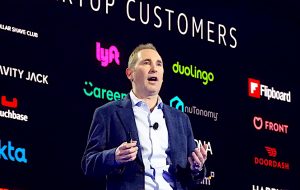 CLOUD
CLOUD
 CLOUD
CLOUD
 CLOUD
CLOUD
Founded nearly a century ago, defense contractor Raytheon Co. wrestles with the same kind of legacy infrastructure burden as any longstanding company, but that hasn’t stopped it from embracing the cloud.
For a recent project, the company adopted the U.S. Air Force’s new Kessel Run agile software development methodology, which relies heavily upon the use of cloud infrastructure.
Developed by the Air Force in partnership with Pivotal Software Inc., Kessel Run was launched initially to rescue a $745 million contract that had produced nothing over a five-year span. Using faster DevOps development techniques and a cloudlike platform as a service enabled Raytheon to dramatically cut delivery times.
“What took years now takes months and days,” David Appel, vice president of defense and civil solutions at Raytheon, said at the VMworld conference this year in an interview on theCUBE, SiliconANGLE’s streaming video platform (below). “It’s been a fantastic journey.”
Delivering applications more quickly to the field has improved flight crew safety and enabled the Air Force to realize $200,000 a day in fuel cost savings months earlier than it would have seen using traditional “waterfall” development. For Raytheon, one of the most eye-opening benefits was its ability to find people.
“We’re finding that it’s been very easy to deploy, very easy to train people up and very easy to operate,” Appel said of the cloud platform, contrasting it to nearly extinct mainframe skills. “It’s just been fantastic from not just the technology perspective but also the cultural transformation perspective.”
Raytheon’s experience is emblematic of the way attitudes toward cloud computing are changing in the enterprise. Originally adopted mainly as a cheaper and more convenient alternative to on-premises infrastructure, the cloud today is widely regarded as an essential tool in achieving the speed and organizational agility that are fueling the scramble for digital transformation. That’s setting the stage for what many experts believe will be a massive migration of on-premises workloads to the cloud in the near future.
The next evolution of cloud computing will be explored in depth at this week’s annual re:Invent in Las Vegas, the most widely attended cloud conference. Thousands of hardware, software and service providers will be touting myriad products for paving that on-ramp to the cloud.
Show organizer Amazon Web Services Inc., the largest cloud infrastructure provider, by itself is expected to debut dozens of new products to make cloud computing more capable. One likely marquee announcement: the availability of and details about its widely anticipated Outposts hybrid-computing hardware and services tipped at last year’s re:Invent. It’s aimed directly at the coming migration, with an aim to help those enterprises forge a more seamless connection between their data centers and the cloud.
And AWS isn’t alone. Microsoft Corp.’s Azure Stack, which brings its cloud infrastructure on-premises, has been available since late 2017, and earlier this month it released Azure Arc to enable Azure cloud services to be deployed on any hardware or even other cloud providers. In April, Google LLC announced a similar approach called Anthos for its cloud services, including a cloud migration service.
By most estimates, less than 20% of enterprise workloads have moved from on-premises to cloud infrastructure. Many of those early candidates were of the “lift and shift” variety: packaged applications with few modifications running on standard infrastructure.
The next generation to transition will be applications that are “more complex and whose impact on the organization is more significant, including enterprise resource planning and supply chain management software,” said Colin Dawes, chief solution architect at Montreal-based managed service provider Syntax Systems Ltd.

“How much has your organizational effectiveness changed due to cloud computing?”
Source: Unisys Cloud Success Barometer, 2019
“When you get past 20%, you’ve crossed the chasm,” said Stu Miniman, a senior analyst at Wikibon, SiliconANGLE’s sister market research firm. “You’re past the early adopters and getting into majority.” Miniman drew an analogy to server virtualization, which took off at about the same penetration point. “Somewhere in the 20% to 40% range, there was no reason not to do it,” he said.
Craig Lowery, a research director in the technology and service provider group at Gartner Inc., believes up to half of enterprise workloads will be running on public or private cloud infrastructure within five years. “There’s been a change in sentiment from lift-and-shift to a cloud-native mentality,” he said. “It’s not about just getting things into cloud; it’s about using cloud properly.”
“Cloud-native” refers to a new breed of applications built using rapid development techniques specifically for cloud infrastructure. They’re characterized by modularity, portability, extreme scalability and resilience.
Although many legacy applications can’t take full advantage of cloud-native features, technologies such as cloud-based virtualization and software containers are paving the way for many to gain at least some of the benefits at little risk. “There’ll be 50 billion new applications written in next five to 10 years and most will be cloud-native,” Miniman said.
Not every workload will invariably move to cloud infrastructure. In fact, some early candidates are even coming back. A recent survey of 2,650 information technology managers underwritten by Nutanix Inc. found that 73% have shifted at least one application back on-premises from public cloud, with 22% moving five or more. International Data Corp. reported a similar trend last year.
Early enterprise cloud users found themselves in what the Nutanix report called the “messy middle,” forcing them to “find workarounds for the immaturity of cloud interoperability and mobility… As a result, the ‘devil you know’ – in this case, the on-prem, non-cloud-enabled data center — appears to have gained favor as at least a short-term solution to these issues.”

Nutanix’s Pfeiffer: “There isn’t some sort of overarching goodness about cloud.”
Photo: SiliconANGLE
“There isn’t some sort of overarching goodness about cloud,” said Wendy Pfeiffer, Nutanix’s chief information officer. “There’s always movement from cloud to cloud and mode to mode which is a reflection of IT portfolio management we’ve been doing for the last 35 years.”
But cloud migration isn’t slowing. The Nutanix survey found that while nearly one-quarter of companies currently aren’t leveraging any cloud infrastructure today, that figure will drop to just 3% in two years’ time. “Cloud penetration is still minuscule,” said David Linthicum, chief cloud strategy officer at Deloitte Consulting LLP and a prominent writer and columnist about cloud-related topics.
The incentives to shift more workloads to cloud infrastructure are becoming increasingly compelling. Linthicum estimated that about 70% of IT-related research and development spending is now targeting cloud platforms. “The systems on-prem aren’t going to get the love that they get in the cloud,” he said.
A recent survey of 1,000 IT and business managers by Unisys Corp. found that 37% of U.S. businesses say they’ve failed to realize significant benefits from cloud computing, “largely because they have not integrated their adoption plan as a core part of their broader business transformation strategy.” The same survey reported that 77% of businesses for which cloud was a core part of their strategy saw great or moderate improvements from their cloud migration. Early missteps have CIOs assessing their options more strategically.
Their decisions are supported by a better understanding of underlying economics of the pros and cons of cloud platforms and steadily improving tools for assessing deployment options. Nutanix’s Pfeiffer uses the company’s Beam multicloud governance platform to conduct what-if analysis “to determine, for example, what it costs to run 24-by-7 or with certain response times both in the cloud and on-prem,” she said. “I can make decisions as to the most cost-effective place to run my applications.”
There are more options than in the past, including co-location, on-premises cloud infrastructure and specialized technologies that can “wrap” legacy applications in a cloudlike package. The high levels of automation inherent in cloud infrastructure are also appealing at a time of historic IT labor shortages.
Not least, there’s the simple fact that momentum has shifted away from on-premises infrastructure. “Why would you build new data centers?” asked Miniman.

AWS’s Jassy: “Virtually all your competitors are going to be using the cloud.”
Photo: Robert Hof/SiliconANGLE
Increasingly, the competitive landscape is also driving decisions. “Today, virtually all your competitors are going to be using the cloud, which means that they’re going to have a lot more capability and innovate at a much faster clip,” AWS CEO Andy Jassy said in an interview with SiliconANGLE Media co-CEO John Furrier. “You have to equip yourself with the same opportunity.”
In short, all the factors are in place to propel a new way of migration. The question is what kind of applications will be the next to make the shift. “We’ve picked the low-hanging fruit,” Linthicum said. “We have to trudge to the harder apps.”
Decisions will be influenced by both practical and strategic considerations. Any virtualized workloads running on Microsoft Windows or standard Linux platforms are a natural starting point, and cloud providers are all trying to make that choice a no-brainer.
“All X86 Linux-based applications are opportunities to gain better costs by collapsing the stack, taking a step toward microservices and using the full registry of published containers as a starting point for rewriting,” said Robert Christiansen, chief cloud strategist at Hewlett Packard Enterprise Co.’s Cloud Technology Partners subsidiary.
The portable operating environments called containers are a significant incentive for organizations to migrate their already virtualized applications. Containerizing applications that have already been virtualized is relatively straightforward and provides “a comfort factor that there is a path beyond lift-and-shift,” said Amit Zavery, vice president of product and engineering for Google Cloud Platform.
Containers not only enhance portability but free administrators from managing infrastructure tasks such as virtual machine maintenance and patching while laying the foundation for encapsulating applications as services that can be wrapped in more modern, cloud-native form. Gartner has estimated that more than 70% of global organizations will be running more than two containerized applications in production by 2023, up from fewer than 20% this year.
“With containers you’re no longer thinking about infrastructure. You’re thinking about portability and being able to run your application anywhere,” said Raj Raman, chief technology officer at Unisys.
Cloud providers are doing all they can to enable the shift. Linthicum estimates that half of the new tooling cloud infrastructure providers will deliver over the next two years will be oriented toward making migration easier. “They’re trying to lubricate the process,” he said.
For example, AWS’ three-year-old partnership with VMware Inc. is primarily aimed at smoothing the way for customers to shift existing virtualized workloads to the cloud. The company’s as-yet-unshipped Outposts managed hardware suite will enable customers to test workloads in an AWS environment before migration and provide an easy path to the vendor’s cloud, an approach that Gartner Inc. analyst Craig Lowery calls a “tethered hybrid cloud. It’s a way to give customers a hybrid cloud solution while still keeping them close to their infrastructure stack,” he said.

Google’s Zavery: Containers provide “a comfort factor that there is a path beyond lift-and-shift.”
Photo: SiliconANGLE
Putting an exact duplicate of a public cloud provider’s infrastructure inside a customer’s data center “brings it closer to the legacy applications that companies were reluctant to move outside the firewall,” said Jeff Kaplan, managing director of THINKstrategies Inc., a consulting firm that specializes in on-demand computing services. “The proximity factor makes customers more comfortable thinking about moving stuff behind the firewall onto that cloud platform.”
Google recently acquired CloudSimple Inc., whose technology enables workloads running on VMware to move quickly to the cloud. “It recognizes the customer’s VMware footprint and what can be moved, then automates the whole process,” Zavery said. Migrating applications one at a time is costly, he noted.
“Automation will be the big driver in the next generation of applications to move,” he said. Google also recently joined Amazon and Microsoft in offering a “bare-metal” option, meaning the virtual machine is installed directly on servers rather than on an operating system on the server, for workloads that aren’t virtualized, an option Zavery said has seen “a lot of demand.”
Another important driver will be CIOs’ growing preference to process big-data workloads in the cloud using platforms such as Amazon’s Redshift, Google’s BigQuery and Snowflake Inc.’s eponymous data warehouse. “I’m seeing a much more near-term trend around analytics databases driving new compute and storage models,” said David Vellante, chief analyst at Wikibon.
Forrester Research Inc. estimates that global spending on big-data cloud subscriptions is growing 7.5 times faster than on-premises subscriptions. “People are running away from the older-guard, commercial proprietary relational databases,” Jassy said.
Some workloads will never be good candidates for public cloud. For example, 30-year-old mainframe applications written in Cobol or assembly language are typically tied tightly to the underlying hardware and can’t even be virtualized, much less run in the constantly shape-shifting cloud environment. Similarly, applications written for niche platforms like IBM’s AS/400, Digital Equipment Corp.’s VMS and some versions of Unix will be marooned.
And then there are the applications that are so old that, as Experian plc CIO Barry Libenson has said, “no one wants to shut them down because they don’t know if they’ll start back up.”
Users who want to rid themselves of responsibility for those legacy platforms will find options with co-location and managed service providers who will take hardware maintenance off their hands but won’t pave a migration path to the cloud. “Organizations will maintain a number of legacy applications, but they will outsource the operational aspects to managed services providers who specialize in those workloads,” said Syntax’s Dawes.
“Mainframe workloads probably never will shift, but companies will want someone to run it for them,” said Google’s Zavery. “They want to reduce the work they do in their data center and at least operate in a hybrid way. The tooling is getting better.”
Migration also isn’t the only alternative to making legacy software cloudier. For example, cloud optimization and migration service provider Corent Technology Inc. has a platform-as-a-service offering that converts on-premises software to a multitenant SaaS application running on AWS, Azure and other clouds. It automates the complexity of configuring dedicated databases and application servers to support multiple logical sessions.

Corent’s Fatehi: One million applications could be converted to SaaS model.
Photo: Corent
CEO Feyzi Fatehi estimates there are at least 1 million applications that are candidates for conversion to multitenant deployment in the largest 2,000 U.S. companies alone. “The first chapter of cloud was about creating efficient infrastructure; the next is about running software efficiently on the cloud.” he said. “What VMware did for hardware Corent is now doing for software.”
The greatest barrier to an even larger migration may be the cloud providers themselves, said Nutanix CIO Pfeiffer. “The consumption models are still built with the assumption that we will choose one mode or vendor,” she said. “The substrate needs to enable application mobility.”
Nutanix has a horse in that race, of course, but Pfeiffer said the issue goes beyond a single product. Each cloud provider takes a different approach to monitoring and managing infrastructure and incentives to make it difficult for customers to move workloads back on premises to another cloud.
“Each cloud vendor also has its own special version of the operating system,” she said. “That’s useful for them. It’s not useful for the enterprise IT people who are buying this stuff.”
That issue will take time to sort out, but probably less than the 50 years hardware makers sparred over whose platform would prevail. In the end, it was nobody’s, and that’s a scenario that would suit most CIOs just fine.
THANK YOU